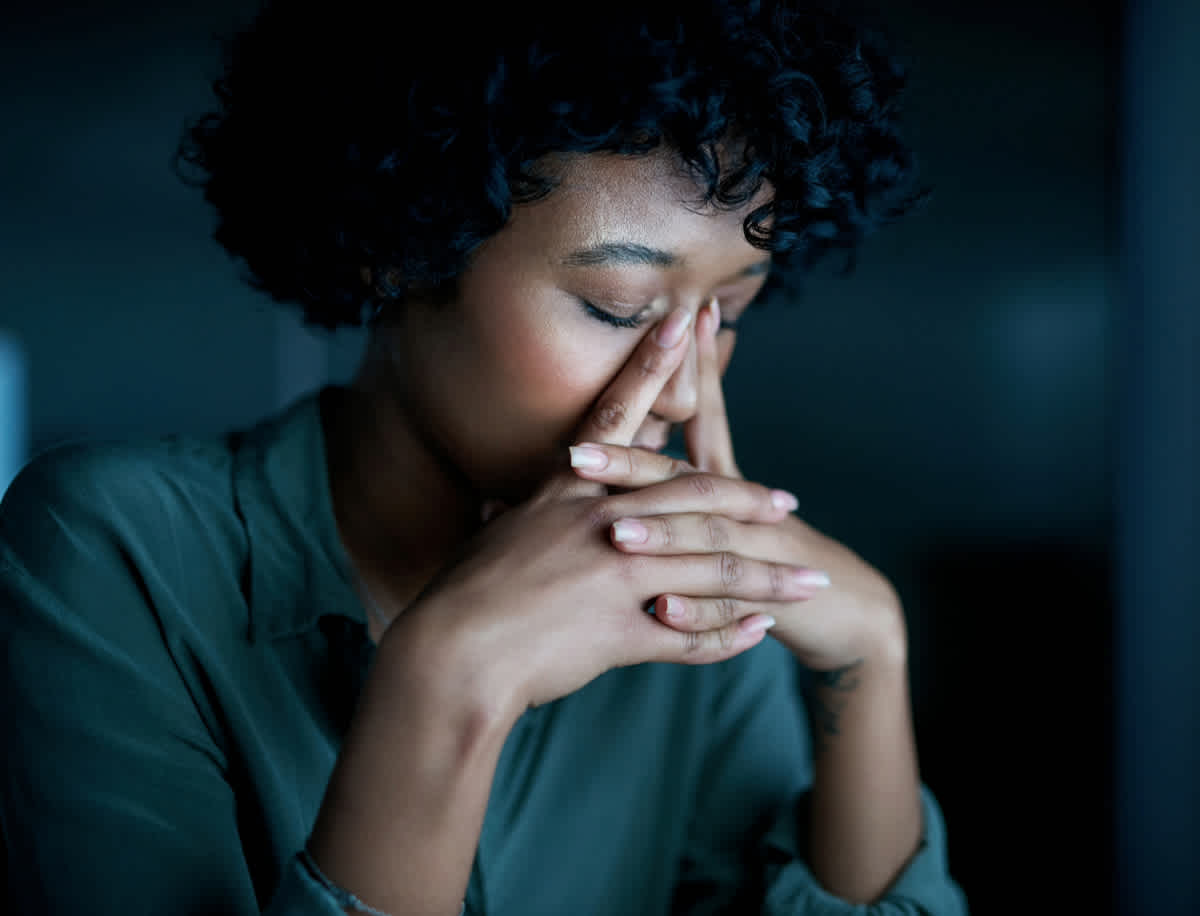Am I Depressed? Try A Self Assessment To Find Out

Feeling a lack of energy, the loss of pleasure in daily activities, and experiencing sleep disturbances can be familiar feelings for all of us. However, it's important to know that if these feelings persist and affect our lives substantially enough to be considered depression [1].
The amount of research surrounding depression is staggering due to its abundance in today's society. There are tools that can help you determine if you may have depression as well as numerous methods in which you can identify the root of your depression, ease your symptoms, and help you overcome it.
PHQ-9 Depression Self-Assessment
Try this self-assessment based on the criteria outlined by the American Psychiatric Association's official DSM-5 Major Depressive Disorder Diagnosis. The test should only take 1-2 minutes.
Your results of this self-assessment are not a replacement for a professional diagnosis, nor is this test meant to be a proper diagnostic tool. Please use it only for educational purposes and talk to your doctor about all your symptoms.
The Depression Epidemic
Depression, or "major depressive disorder", is the main cause of disability worldwide according to the World Health Organization. It can affect adults, adolescents, and children[2].
Major depressive disorder is also one of the most common mental health conditions in the United States, affecting more than 17 million Americans each year. Symptoms of depression extend far beyond feelings of sadness; many patients experience fatigue, changes in appetite, and sleep disturbances, among others listed below. It can cause the affected person to suffer greatly and function poorly at work, at school, and in the family.
At its worst, depression can lead to suicide. Sadly, over 700,000 people die due to suicide every year[2]. Suicide is the fourth leading cause of death in people between the ages of 15 and 29 years olds. People with depression find it difficult to identify their condition and seek help because they suffer from a variety of symptoms and are concerned about social stigmas of mental health stereotypes.
Depression and the PHQ-9
Psychologists use a variety of methods to diagnose depression, including physical examinations and checking symptoms against the Diagnostic and Statistical Manual of Mental Disorders (DSM-5), published by the American Psychological Association.
One of the most common evaluations is the PHQ-9 (Patient Health Questionnaire-9), which quantifies common symptoms and allows professionals to monitor their severity based on the DSM-5 criteria for depression[3].
The Patient Health Questionnaire (PHQ) is a new tool for making criteria-based diagnoses of depressive and other mental disorders commonly encountered in primary care. The diagnostic validity of the PHQ has recently been established in two studies involving 3,000 patients in 8 primary care clinics and 3,000 patients in 7 obstetrics-gynecology clinics.
With 9 criteria, the PHQ depression scale is half the length of many other depression measures, has comparable sensitivity and specificity, and consists of the actual 9 criteria upon which the diagnosis of DSM-IV depressive disorders is based. The latter feature distinguishes the PHQ-9 from other "2-step" depression measures for which, when scores are high, additional questions must be asked to establish DSM-IV depressive diagnoses.
In addition to visiting your doctor to see if you might have depression, self-evaluations are simple tools that can assist in assessing your depression risk.
Depression Symptoms
Contrary to the social stigma regarding depression, depression's only symptom is not only feeling sad. It can have other major effects on your body and mind. Men and women can also experience a variety of different specific symptoms and have differences in their expression and onset [5].
Symptoms of depression can include:
Feeling sad, anxious, or "empty"
Feeling hopeless, worthless, and pessimistic
Crying
Feeling bothered, annoyed, or angry
Loss of interest in hobbies and interests you once enjoyed
Decreased energy or fatigue
Difficulty concentrating, remembering, or making decisions
Sluggish movement or speech
Difficulty sleeping, early-morning awakening, or oversleeping
Appetite and weight changes
Chronic physical pain with no clear cause that does not get better with treatment (headaches, aches or pains, digestive problems, cramps)
Thoughts of death, suicide, self-harm, or suicide attempts
Symptoms of Depression in Males
Depression can oftentimes differ in its onset and expression in men and women.
Depression symptoms in males can include:
Mood issues — such as anger, aggressiveness, irritability, anxiousness, or restlessness.
Disturbed emotional well-being — such as feeling empty, sad, or hopeless.
Behavioral problems — such as substance abuse, loss of interest in activities, etc.
Reduced sexual interest — such as reduced sexual desire or lack of sexual performance.
Cognitive troubles — such as inability to concentrate, difficulty completing tasks, or delayed responses during conversations.
Troubled sleep patterns — such as insomnia, restless sleep, excessive sleepiness, etc.
Physical symptoms — such as fatigue, pains, headache, or digestive problems.
Symptoms of Depression in Females
Depression symptoms in females can include:
Mood issues — such as irritability.
Disturbed emotional well-being — such as feeling sad or empty, anxious, or hopeless.
Behavioral problems — such as loss of interest in activities, withdrawing from social engagements, or thoughts of suicide
Cognitive troubles — such as thinking or talking more slowly.
Troubled sleep patterns — such as difficulty sleeping through the night, waking early or sleeping too much.
Physical symptoms — such as decreased energy, greater fatigue, changes in appetite, weight changes, aches, pain, headaches, or increased cramps.
Symptoms of Depression in Children
Children may also see symptoms specific to their group that can make schoolwork and socializing difficult.
Depression symptoms in children can include:
Crying
Low energy
Clinginess
Defiant behavior
Vocal outbursts
What are the Types of Depression?
So you've taken the test and may have discovered that you are at risk of having mild to severe depression; what's next? In tandem with reaching out to a mental health professional, it's important to come to an understanding that depression comes in various forms and may stem from multiple sources or afflictions.
Sometimes, depression may not even have an obvious cause and can linger for a long time for no clear reason.
Types of depression include [6]:
Major Depressive Disorder
Major depression (clinical depression) has intense or overwhelming symptoms that last longer than two weeks. Symptoms may interfere with everyday life.
Bipolar Depression
People with bipolar disorder have alternating periods of low mood and extremely high-energy (manic) periods. During the low period, they may have depression symptoms such as feeling sad or hopeless or lacking energy.
Perinatal and Postpartum Depression
"Perinatal" means around birth. Many people refer to this type as postpartum depression. Perinatal depression can occur during pregnancy and up to one year after having a baby. Symptoms go beyond "the baby blues," which causes minor sadness, worry, or stress.
Persistent Depressive Disorder
PDD is also known as dysthymia. Symptoms of PDD are less severe than major depression. But people experience PDD symptoms for two years or longer.
Premenstrual Dysphoric Disorder
Premenstrual dysphoric disorder is a severe form of premenstrual disorder (PMS). It affects women in the days or weeks leading up to their menstrual period.
Psychotic Depression
People with psychotic depression have severe depressive symptoms and delusions or hallucinations. Delusions are beliefs in things that are not based in reality, while hallucinations involve seeing, hearing, or feeling touched by things that aren't actually there.
Seasonal Affective Disorder
Seasonal depression, or seasonal affective disorder, usually starts in late fall and early winter. It often goes away during the spring and summer.
Contributing Factors and Prevention
After understanding your own risk for depression, the various symptoms we can express and the different types of depression that exist, it's very important to know the contributing factors to depression and how we can prevent them.
Biological, social, and psychological factors are all involved in the development of depression [2]. Normal yet negative life events such as unemployment, bereavement, and traumatic events can increase the likelihood of a person developing depression. As a result, depression can exacerbate the affected person's life situation and this will most likely worsen their depression.
For individuals who have experienced trauma, the connection between traumatic experiences and depression is particularly important to address through comprehensive treatment.
Active Prevention
Physical health is also a contributing factor to both developing depression and eliminating it. For example, cardiovascular disease can lead to depression and vice versa [7]. Numerous case studies have concluded that, at least for some, moderate-intensity exercise can be beneficial for depression and can result in a happier mood.
Walking, jogging, running, or playing your favorite sport can all play a part in preventing depression or even lessening its effects over time. Getting fresh air and direct sunlight may also be helpful if you find yourself stuck inside for most of the day.
Treatment for Depression
Depression is a serious mental health condition that can worsen without professional treatment. Untreated depression can impact every area of your life, contributing to physical and psychological complications such as substance abuse, relationship difficulties, and social isolation.
Since this condition affects millions of people each year, there are many treatment options for depression. Different treatments work best for different patients and different types of depression, so it is important to speak with your doctor to determine which options are right for you.
Treatment options include [6]:
Medications
Such as selective serotonin reuptake inhibitors (SSRIs). Medication management is an important aspect of depression treatment that requires careful monitoring and adjustment.
Self-care
Mending certain life circumstances that may have led to depression.
Therapies
Such as support programs, interventions, counseling, or cognitive behavioral therapy. Other effective approaches include individual therapy, group therapy, and dialectical behavior therapy.
Treatment Programs
Professional treatment programs offer various levels of care depending on the severity of symptoms and individual needs:
Outpatient treatment for ongoing support while maintaining daily responsibilities
Intensive outpatient program for more structured support
Partial hospitalization for intensive daily treatment
Virtual telehealth options for convenient access to care
For individuals dealing with both depression and substance use issues, co-occurring disorders treatment addresses both conditions simultaneously for the best outcomes.
You Can Win the Fight Against Depression
After taking the PHQ-9 self-test, you may have discovered you are at risk of having mild to severe depression. While this might be unsettling, know that effective treatment is available and depression is highly treatable with the right professional support.
Evidence-based treatment approaches have helped millions of people overcome depression and reclaim their lives. Whether you're dealing with major depression, bipolar disorder, or other mood disorders, there are proven treatments that can help.
Find Professional Help for Depression
If your self-assessment indicates you may be experiencing depression, it's important to reach out for professional help. Depression is a treatable condition, and seeking help is a sign of strength, not weakness.
Use our treatment directory to find qualified mental health providers in California who specialize in depression treatment. Our directory includes providers who accept various insurance plans and offer different treatment approaches, from traditional therapy to innovative treatments, to help you find the right fit for your specific needs and circumstances.
Remember, you don't have to face depression alone. Professional support can help you develop the tools and strategies needed to overcome depression and live a fulfilling life.
Sources
Medical News Today (2021, November 19) What is depression and what can I do about it? Retrieved November 11th, 2021 from https://www.medicalnewstoday.com/articles/8933
World Health Organization (2021, September 13) Depression. Retrieved November 11th, 2021 from
https://www.who.int/en/news-room/fact-sheets/detail/depression
Kroenke, K. M.D. (2001, September 6) The PHQ-9. Retrieved November 11th, 2021 from
American Psychological Association. Patient Health Questionnaire 9. Retrieved November 11th, 2021 from
https://www.apa.org/depression-guideline/patient-health-questionnaire.pdf
Cleveland Clinic (2020, December 31) Depression. Retrieved November 12th, 2021 from
https://my.clevelandclinic.org/health/diseases/9290-depression
Saripalli, V. Psy.D (2020, November 1) Everything You Need to Know About Depression. Retrieved November 12th, 2021 from https://www.healthline.com/health/depression
Craft, L. L., & Perna, F. M. (2004). The Benefits of Exercise for the Clinically Depressed. Retrieved November 12th from https://www.ncbi.nlm.nih.gov/pmc/articles/PMC474733/
Locate Treatment Centers Near You
Enter your location to discover facilities offering the care and support you need in your area.


